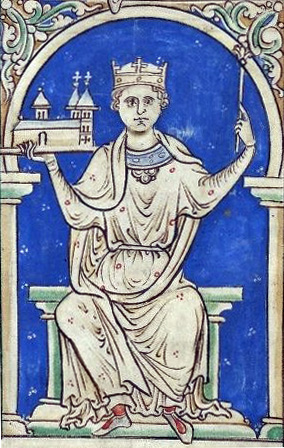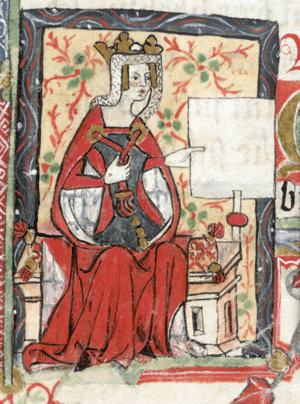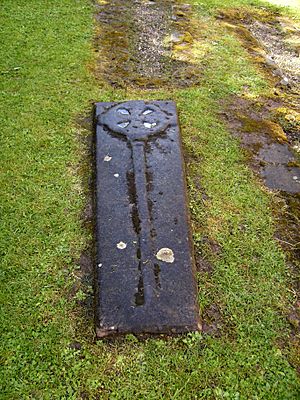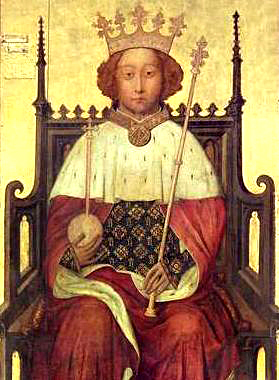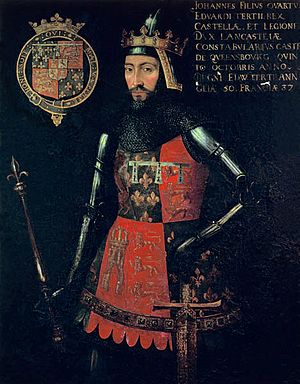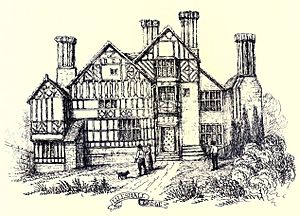Lilleshall Abbey facts for kids
Lilleshall Abbey was a special kind of monastery for Augustinian canons in Shropshire, England. It's about 6 miles north of Telford today. The abbey was started between 1145 and 1148. It followed very strict rules from another abbey called Arrouaise in France. Lilleshall Abbey often had money problems. It just barely avoided being closed down in 1536, but then decided to close voluntarily in 1538.
Contents
How Lilleshall Abbey Started
Early History and Strict Rules
Lilleshall was one of the few monasteries in England that belonged to the strict Arrouaisian branch of the Augustinians. For a long time, people thought there was an old Anglo-Saxon church at Lilleshall. However, historians now believe the abbey truly began between 1145 and 1148, during the reign of King Stephen.
The abbey was founded by two brothers, Richard and Philip de Belmeis. Richard was an important church leader, and Philip was a powerful landowner. They were nephews of a former Bishop of London. These brothers wanted to create a new religious community.
The Belmeis Family's Plan
The Belmeis brothers had a lot of land and power in Shropshire. Philip first showed interest in another abbey, but then decided to support the Arrouaisian canons from Dorchester Abbey. He gave them land in Staffordshire to build a church.
The canons tried to settle in a few places before finding their final home at Lilleshall by 1148. Richard de Belmeis helped a lot. He had control over a wealthy church in Shrewsbury called St Alkmund's. Richard came up with a big plan: he would close down St Alkmund's and use its money to fund the new Arrouaisian community at Lilleshall. This was similar to how Dorchester Abbey was founded.
England was in a period of civil war, known as the Anarchy, during King Stephen's reign. So, it was very important to get permission from many powerful people. King Stephen himself gave a special charter in 1145, allowing Richard to give his lands to the canons. Important church leaders and nobles witnessed this.
To make sure the abbey would last, they also needed the approval of Empress Matilda, who was fighting King Stephen for the throne. She gave her consent in 1148. Later, her son, who became King Henry II, also agreed. Because it replaced a royal church, Lilleshall Abbey was seen as a royal foundation. This meant it had special benefits but also duties to the king.
What the Abbey Was Dedicated To
The abbey was dedicated to Saint Mary, the mother of Jesus. This was mentioned in Philip de Belmeis's first charter. The abbey's seal from the 13th century also clearly states: "The Seal of the Church of St Mary of Lilleshall."
Life at the Abbey
The people living at Lilleshall Abbey were Augustinian canons, not technically monks. Even though the Arrouaisian order was known for its strictness, their houses were less isolated than those of other monks. They were also known for their beautiful church services. A prayer list from around 1375 shows that Lilleshall kept up this tradition for over 200 years.
Many wealthy landowners gave gifts to the abbey. Often, they asked to be buried there or to be included in the abbey's prayers. For example, a local baron named John Lestrange gave a church to Lilleshall Abbey. He did this for the well-being of his and his wife's souls. Later, he added another church, specifically asking for his wife, Amicia, to be buried at Lilleshall when she died. This shows that the abbey quickly gained a reputation for holiness. People believed that being close to the abbey, even in death, could bring spiritual benefits.
The abbey had many employees. In the mid-1400s, there were over twenty household servants. These included porters, cooks, a baker, a bell-ringer, and even a washerwoman. There was also a tannery (for making leather) and a brewery on the abbey grounds. Being self-sufficient was very important for Arrouaisian abbeys.
The canons spent a lot of time managing the abbey's large estates. These lands were mostly worked by hired laborers. The abbey kept a good portion of its land for its own use, cultivating it from special farms called granges. Lilleshall alone had four granges, and there were more in Shropshire and Staffordshire. Sometimes, canons had to travel to these distant granges, which was unusual for their strict rules. Over time, the abbey started leasing out more of its land instead of working it directly.
Lilleshall Abbey wasn't famous for its scholarly work. However, it did have a library. A copy of a historical book, with local additions, has survived from the abbey. One canon was even allowed to study at a university for 10 years starting in 1400.
John Mirk, a canon at Lilleshall in the late 1300s and early 1400s, became a known writer. He wrote in the local dialect of Middle English. Two of his books were widely copied. His Festial was a collection of sermons for church festivals. His Instructions for Parish Priests was a lively poem that helped priests give good advice to their church members. This shows that the canons were involved in the religious life of their area.
Abbey's Riches and Gifts
Lilleshall Abbey was supported by many lands and properties. These were mostly given to the abbey during its first 100 years. At first, most of its properties were close to the abbey. But over time, they spread out to other areas.
The abbey also had many important rights. Pope Alexander III said the abbey didn't have to pay tithes (a type of tax) on its own lands. In 1269, the abbot was allowed to hold an annual fair at Atcham, lasting three days. Seven years later, he got permission for another fair there.
The main properties given to the abbey were from the St Alkmund's church and the Belmeis family. These were mostly in Shropshire and Staffordshire. The abbey also had significant holdings in Leicestershire and Derbyshire, which meant canons had to travel to manage them. Other powerful families in the area also gave gifts, but these were often smaller compared to what they gave to other nearby abbeys. Lilleshall's lands were spread out, which made them more expensive to manage and meant less local support.
Challenges and Decline
Lilleshall Abbey was a large and important Augustinian house. It seemed to be at its strongest during the time of King Henry III. However, around this time, it also started to misuse some of its special rights. For example, in 1221, people complained that the abbot's servant was caught with stolen goods. The abbot took the servant from jail to try him in his own court, and no one knew the outcome. Still, the abbey generally had good relations with the king. In 1242, the king gave the abbot a gift of 20 marks.
In 1292, King Edward I questioned Abbot William of Bridgnorth for going too far with his privileges. The abbot was accused of holding courts for serious crimes that only royal courts should handle. He was also claiming rights to hold fairs and markets on his lands without proper permission. The outcome of this case is not known.
Even though the abbey had a lot of property, it faced serious money problems by the early 1300s. This was during the time of Bishop Roger Northburgh, who was a strict reformer. He found the abbey deeply in debt. He criticized the abbot for not getting enough advice on spending money. He also pointed out that too many "corrodies" were being given away. Corrodies were like pensions, giving people food and clothing for life. They were often given to royal employees or sold cheaply, which drained the abbey's money.
The abbot at this time, John of Chetwynd, was known for causing trouble. He was accused of having armed followers and protecting a person who had robbed a royal official. He also avoided court summons. Despite his past, when he retired in 1330, he was given a generous income and a large home at the abbey. But this wasn't enough for him. The former abbot then took over the abbey by force and stole from it! King Edward III had to send officials to restore order. This was a very low point for the abbey's reputation.
The abbey's lands were spread out, making them costly to manage. Also, being a royal foundation meant the abbey had to provide for royal employees, which was a constant drain on its finances.
John's successor, Henry of Stoke, tried to fix the abbey's money problems. He hired a skilled lawyer, William of Shareshill, to help increase the abbey's income. Shareshill was very successful. However, cattle diseases in the 1330s and the first outbreak of the Black Death in 1348 hit the abbey hard. The shortage of workers brought the community to its knees. Abbot Henry resigned in 1350.
King Richard II and Queen Isabella visited the abbey in January 1398. They came with many important nobles and a huge group of followers. This visit would have been very expensive for the abbey. However, John of Gaunt, the king's uncle, visited a few days later and made a large money gift, which helped the abbey.
The abbey's finances probably got better in the late 1300s and early 1400s. They used a system where money from certain estates was set aside for specific purposes. This helped keep the abbey out of serious trouble for some time. But by 1518, problems returned. A church inspection found the abbey was deeply in debt. The bishop also criticized some canons for bad behavior and said there was no schoolmaster. He told the abbot to get rid of unnecessary staff, which helped the abbey recover financially in its final years.
The Abbey's Closure and What Happened Next
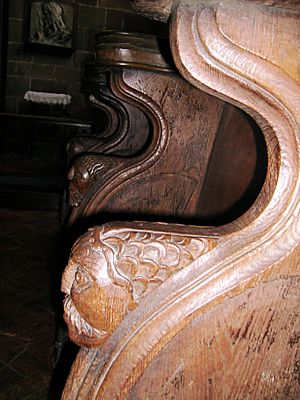
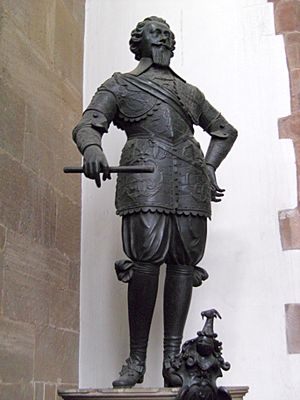
In 1535, Lilleshall Abbey was checked as part of a survey before King Henry VIII closed down smaller monasteries. Its income was just above the limit, so it wasn't immediately closed. However, like many other monasteries, it eventually surrendered to the king on October 16, 1538.
William Cavendish, the king's agent, arrived to take control of the abbey lands and buildings. At this time, there were only Abbot Robert Watson and ten canons left. Abbot Watson was given a pension and a house. The other canons also received pensions and a small payment when they left. The abbey's belongings, from church items to beds and cooking pots, were sold. The livestock and grain were also sold.
On November 28, the king gave the abbey site to Cavendish. A year later, it was sold to James Leveson, a wealthy merchant. The Leveson family was connected to St Peter's Collegiate Church in Wolverhampton. James Leveson sent choir stalls from the abbey to this church, where you can still see them today. In 1543, Leveson bought the entire manor of Lilleshall from the Crown, creating a country estate for his family. He likely started building a lodge near the abbey site as a family home.
James Leveson died in 1547, and his son Richard inherited the estate. Richard's son, Walter Leveson, got into serious trouble. He was involved in piracy and faced huge fines and time in prison. By the time he died, he was deeply in debt. His cousin, John Leveson, and later John's wife Christian, worked hard to pay off the debts. Christian even leased the estate back from the Crown when it was seized. By 1623, all the debts were paid.
The abbey and manor then passed to another Sir Richard Leveson. During the English Civil War in 1643, he fortified the abbey site and put 160 soldiers there. Parliamentary forces attacked the abbey, destroying parts of the church before the soldiers surrendered. After Sir Richard's death in 1661, the manor eventually went to the Leveson-Gower family.
The Levesons never lived full-time at Lilleshall. They saw it as a hunting lodge or country retreat. In the 1750s, a new Hall was built elsewhere on the estate. In 1820, an even grander Hall was built, moving the family's main focus away from the abbey ruins. Mining in the area later damaged the abbey walls.
Today, the abbey site is cared for by English Heritage. It is open to visitors most days, and there is no charge to enter.
What Remains of the Abbey
The abbey church was built in the 1100s and 1200s. Its large size shows that it had rich supporters. The surviving abbey buildings mostly date from the late 12th and early 13th centuries. Other buildings are gone, but their foundations were found during digs in the late 1800s. The main buildings were part of a much larger area, surrounded by a stone wall and gates. Old yew trees are now a key feature of the site, especially on the south side near the cloister. English Heritage now looks after the abbey remains.
The ruins of the abbey church are still impressive, with most of the main walls still standing. In the 1960s, they had to be supported with wood because of damage from mining. The church was shaped like a cross and was over 60 meters long.
Visitors first see the grand west front, with a wide main doorway under a round arch. This part was finished later, in the 1200s. The huge stone walls on either side once supported a tall western tower, which was probably destroyed during the siege. You can climb a narrow staircase inside the church to get a good view of the ruins and the surrounding area. There's also a small, well-preserved lavabo (a washing basin) on the south wall.
Inside the church, two screens once divided the space. Only their foundations remain, but they are very clear. The oldest parts of the building are the chancel and presbytery, started in the late 1100s. A large, impressive east window was added in the 1300s and still dominates the church.
On the south wall, near the transept, there's an impressive entrance where canons would enter the church in procession from the cloister. The doorway has detailed zig-zag carvings.
The cloister was a garden courtyard surrounded by the abbey's domestic buildings, mostly built in the late 1100s. The eastern buildings, next to the transept, are well-preserved. You can walk through a passage that led to the parlour and chapter house. The south range is mostly in ruins, but its walls still stand. This area contained the refectory (dining hall). In the early 1800s, this range was more complete and likely had the abbot's living area on its upper floor. The abbey also had many other buildings, including large guest facilities for important visitors and their many followers.
- Remains of the abbey buildings



